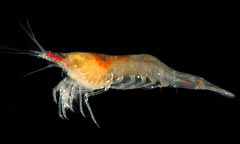The WWF Japan discovers a new species of numa-ebi in the sea off Kumejima

The new species of numa-ebi was collected from an underwater limestone cave at Kumejima Island (photograph courtesy of Yoshihisa Fujita).
June 3, 2011 Ryukyu Shimpo
On June 2, the World Wildlife Fund (WWF) Japan announced that it has discovered a new species of numa-ebi, or Atyidae shrimp, during field research carried at Kumejima Island in February. The numa-ebi species normally inhabits the freshwater of lakes and rivers but the one species discovered at Kumejima was found living in seawater. This is an unprecedented case anywhere in the world.
The shrimp were collected by a team of marine biology researchers including Yoshihisa Fujita, a part-time lecturer at Ryukyu University and other institutions, who were during field work carried out as part of the WWF Japan “Kumejima Backup Project.”
The numa-ebi was found in an underwater cave about 35 meters deep. It is one centimeter in length and has degenerate eyes.
Among the Ryukyu Islands, Kumejima has a high level of biodiversity with some parts of the island being registered as a site in the Ramsar Convention. WWF Japan selected the island as a part of a priority biodiversity conservation area within the Ryukyu Islands.
Fujita said, “We expected that a new species would be found, because a new species of crab was found in the very same place about 10 years ago. With help from divers, we would like to continue this research.”
A conference presentation will be delivered on June 4 in the science complex building of Ryukyu University.
(English Translation by T&CT, Mark Ealey)
Previous Article:Okinawan House to be constructed in New Caledonia as a center for friendship
Next Article:Governor of Okinawa promotes the 5th Worldwide Uchinanchu Festival in Canada
[Similar Articles]
- New species of squid discovered in Okinawa named after Nobel Laureate and OIST founder Sydney Brenner
- New species of spider and goby fish found in Okinawa Prefecture
- Japan’s first ever snake eel that lives in river found in Genka River
- University of the Ryukyus joins the Millennium Seed Bank Partnership, teaming up with British researchers to conserve Yambaru trees for the future
- World’s largest sea cucumber found in Iriomote
 Webcam(Kokusai Street)
Webcam(Kokusai Street)


